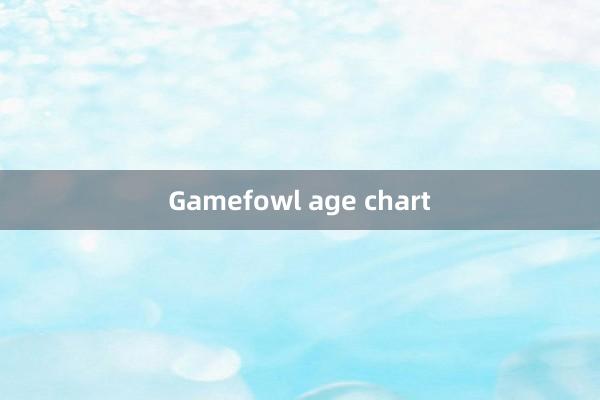
Gamefowl Age Chart: A Comprehensive Guide to Gamefowl Aging
Understanding the growth stages of gamefowl is essential for breeders, trainers, and enthusiasts. Monitoring the age and development of gamefowl allows for better management of their health, feeding, and training. This article presents a gamefowl age chart and discusses how age influences the bird’s care and performance.
The Early Stages: Chicks to Young Gamefowl (0-6 Months)
The first six months of a gamefowl's life are crucial for its overall development. During this time, chicks grow rapidly and require special attention.
0-1 Month: Hatchling Stage
During the first month of life, gamefowl chicks are fragile and dependent on their environment. A warm, clean, and safe space is critical for survival. Chicks need to be kept at a stable temperature, usually around 95°F (35°C), and require high-quality feed rich in protein. They are fed chick starter, which is specifically designed to meet the nutritional needs of young birds.
1-3 Months: Juvenile Stage
At this stage, chicks start developing feathers, and their diet begins to shift slightly. Gamefowl juveniles require a balanced feed that includes more grains and greens. This stage is also important for socialization as the young birds begin to interact with one another. During this period, proper nutrition and care can set the foundation for future health and performance.
3-6 Months: Pullet and Cockerel Stage
Gamefowl are now in the pullet (female) and cockerel (male) stages. They have most of their feathers, and their diet continues to evolve. Feeding should include more protein and calcium to support bone and muscle growth. At this age, young gamefowl become more independent, but they still require close observation for signs of illness or developmental issues.
The Middle Stages: Adolescent to Adult Gamefowl (6-18 Months)
As gamefowl move into adolescence, their care requirements change. They start developing the characteristics that will define them as adult birds.
6-12 Months: Sub-adult Stage
At this stage, gamefowl begin to show their adult plumage, and their behaviors become more pronounced. Cockerels may begin to crow, and both sexes will start developing their muscularity. Feeding should focus on maintaining a balanced diet, emphasizing energy and protein to support ongoing growth. Exercise and free-range opportunities are important to help them develop their natural instincts and improve their strength.
For those training gamefowl for performance, Royale777 this stage is when initial conditioning can begin, sexx ba bau though it should be done cautiously to avoid injury. Some breeders may also start separating the sexes to prevent early mating,Mega ace jili which can be stressful for young hens.
12-18 Months: Maturity
By the age of 12 to 18 months, gamefowl are considered fully mature. Males and females will be at their peak physical condition, and roosters will display their full combs and spurs. This is the age when gamefowl are often evaluated for their performance potential. Roosters may begin sparring, though this should be carefully monitored to prevent injuries. Proper nutrition, hydration, and exercise are essential during this time, as these birds are at their most active and competitive stage.
The Prime Years: Adult Gamefowl (18 Months - 3 Years)
The prime years for gamefowl are typically between 18 months and 3 years. During this time, the birds reach their peak strength, stamina, and fighting ability.
18-24 Months: Peak Condition
At this age, gamefowl are at their prime. Roosters are fully developed, with strong muscles, well-formed spurs, and a robust constitution. These birds are often used for breeding and performance during this period, as they exhibit the best traits in terms of size, strength, and agility.
Gamefowl should be fed a high-energy diet, including grains, greens, and supplements to maintain their health. Conditioning for competitive events is common at this stage, and breeders pay close attention to the birds' diet, training, and overall well-being. Regular exercise and space to roam are important for keeping them in top physical condition.
2-3 Years: Sustained Strength
Gamefowl remain strong and competitive throughout their second and third years. However, signs of aging may start to appear, such as slight changes in stamina or recovery time after competitions. Careful management is needed to ensure the birds maintain their health and vigor.
Senior Gamefowl: 3 Years and Beyond
As gamefowl age beyond three years, their physical condition begins to decline, but they still have value, particularly in breeding.
3-5 Years: Senior Stage
By the time gamefowl reach the age of 3 to 5 years, they are considered seniors. Roosters may still be used for breeding, but their competitive years are typically behind them. They may not have the same energy or stamina as they did in their prime, and their recovery times from exertion will be longer. However, they can still contribute valuable genetics to a breeding program, especially if they have proven to be strong and resilient in their younger years.
5 Years and Beyond: Old Age
Gamefowl over the age of five are generally retired from breeding and performance. While they may still be healthy, their physical abilities have diminished significantly. However, with proper care, many gamefowl can live healthy lives well into their senior years, providing companionship or serving as a part of the farm's heritage.
Conclusion
Understanding the different stages of a gamefowl’s life is crucial for proper care and management. From the delicate early months to the peak performance years and into old age, each stage requires specific attention to nutrition, exercise, and overall health. By following a gamefowl age chart and adjusting care according to the bird’s stage in life, breeders can ensure their birds remain healthy and competitive throughout their lives.
JILI downloadwww.voyeurbrazil.com








